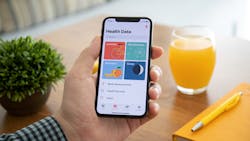University of Utah initiative aims to take digital health to the next level
University of Utah Health has launched a new initiative that seeks to better integrate digital health applications into daily medical care including prevention, diagnosis, and treatment of cancer, heart disease, and other life-threatening conditions.
The Digital Health Initiative (DHI) aims to develop, evaluate, and distribute tools designed to improve mental health, home monitoring, self-care, and patient-centered clinical decision support. The goal is to create health apps that are more scientifically based and reliable than those that are currently available. DHI is supported by a substantial grant from the Office of Senior Vice President for Health Sciences at U of U Health.
These tools will cultivate the well-being of patients and help doctors deliver health care more effectively and efficiently, according to Guilherme Del Fiol, M.D., Ph.D., co-director of DHI and a professor in the Department of Biomedical Informatics at U of U Health.
“Since the onset of COVID-19, we have seen a dramatic expansion of the use of digital health tools such as telehealth,” Del Fiol says. “Patients are more comfortable using this kind of technology at home, either for self-care or to connect with health care systems. So, there’s a tremendous opportunity for even more innovations that will transform how health care is delivered.”
To keep up with this growing demand, DHI plans to drive digital health research forward by developing:
· Mobile apps and games for health
· Virtual reality and sensors
· Clinical decision support tools
· Integration with electronic health records (EHR)
Many of these efforts will be modeled after earlier research U of U Health, including:
· Using a platform that scans electronic health records to identify patients with a family history of cancer. Automated chatbots then reach out to eligible patients, educate them about genetics, and offer genetic testing.
· Using Neurogrow, a video game designed to treat older adults with treatment-resistant depression. The game, which is in clinical trials, allows players to care for a virtual garden. Researchers believe this activity strengthens circuits in the brain that can elevate mood.
· Using text messaging, chatbots, and patient navigation to diminish access barriers to COVID-19 testing. These tools provide tailored information and offer free access to mailed at-home test kits to communities experiencing health disparities.
· Using a digital health application integrated with electronic health records to improve lung cancer screening. The app enables patients and their doctors to review individualized health risk information and make informed screening decisions.
Practical Health Care Apps Needed
The founding of DHI coincides with a huge uptick in health app usage. Estimates suggest that more 350,000 of them are available worldwide, with about 250 new health apps appearing daily. Among the most popular are apps that help monitor exercise, nutrition, weight loss, sleep, and blood pressure.
However, many of these applications fail to follow scientific protocols, don’t work as well as intended, or were developed without consulting physicians, according to Victoria Tiase, Ph.D., R.N., DHI’s director of strategic development.
“Many of these innovations fail to impact the bedside since many are created in a vacuum and really don’t help transform health care,” Tiase says. “There is a need for digital health solutions that are designed to solve a clear problem, involve users at every step, and are thoroughly tested.”
The need for and acceptance of reliable digital health tools among physicians is also growing. According to an American Medical Association survey, the average American doctor uses about four of these tools. More than 80% of the physicians surveyed said using digital health apps improves clinical outcomes, diagnostic ability, patient safety, the doctor-patient relationship, and reduces their stress and burnout.
“We’re fortunate here at U of U Health that we are at the forefront in several areas of digital health,” says Ken Kawamoto, M.D., Ph.D., M.H.S., a DHI co-director and professor of biomedical informatics. “The formation of DHI will bring together many of these digital health care pioneers in a collaborative environment that will strengthen our role in the development of vital digital health innovations.”
Moving forward, DHI directors will recruit more faculty in complementary fields, conduct real-world testing of their innovations, and establish a user-centered design lab where digital app developers can conduct hands-on demonstrations and get feedback from patients who might eventually use the technology.
“Involving end-users in the entire design process is key,” says Roger Altizer, Ph.D., co-director of DHI and a professor in the Department of Population Health Sciences at U of U Health. “We not only need to know if the app will work, but we also need to know if the patients will use it.”
